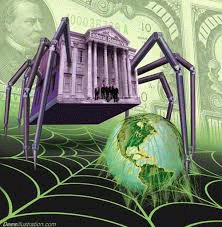December 23rd, 2013, marks the 100th anniversary of the Federal Reserve, warranting a review of its performance. Has it achieved the purposes for which it was designed?
The answer depends on whose purposes we are talking about. For the banks, the Fed has served quite well. For the laboring masses whose populist movement prompted it, not so much.
Thwarting Populist Demands
The Federal Reserve Act was passed in 1913 in response to a wave of bank crises, which had hit on average every six years over a period of 80 years. The resulting economic depressions triggered a populist movement for monetary reform in the 1890s. Mary Ellen Lease, an early populist leader, said in a fiery speech that could have been written today:
Wall Street owns the country. It is no longer a government of the people, by the people, and for the people, but a government of Wall Street, by Wall Street, and for Wall Street. The great common people of this country are slaves, and monopoly is the master. . . . Money rules . . . .Our laws are the output of a system which clothes rascals in robes and honesty in rags. The parties lie to us and the political speakers mislead us. . . .We want money, land and transportation. We want the abolition of the National Banks, and we want the power to make loans direct from the government. We want the foreclosure system wiped out.
That was what they wanted, but the Federal Reserve Act that they got was not what the populists had fought for, or what their leader William Jennings Bryan thought he was approving when he voted for it in 1913. In the stirring speech that won him the Democratic presidential nomination in 1896, Bryan insisted:
[We] believe that the right to coin money and issue money is a function of government. . . . Those who are opposed to this proposition tell us that the issue of paper money is a function of the bank and that the government ought to go out of the banking business. I stand with Jefferson . . . and tell them, as he did, that the issue of money is a function of the government and that the banks should go out of the governing business.
He concluded with this famous outcry against the restrictive gold standard:
You shall not press down upon the brow of labor this crown of thorns, you shall not crucify mankind upon a cross of gold.
What Bryan and the populists sought was a national currency issued debt-free and interest-free by the government, on the model of Lincoln's Greenbacks. What the American people got was a money supply created by private banks as credit (or debt) lent to the government and the people at interest. Although the national money supply would be printed by the U.S. Bureau of Engraving and Printing, it would be issued by the "bankers' bank," the Federal Reserve. The Fed is composed of twelve branches, all of which are 100 percent owned by the banks in their districts. Until 1935, these branches could each independently issue paper dollars for the cost of printing them, and could lend them at interest.
1929: The Fed Triggers the Worst Bank Run in History
The new system was supposed to prevent bank runs, but it clearly failed in that endeavor. In 1929, the United States experienced the worst bank run in its history.
The New York Fed had been pouring newly-created money into New York banks, which then lent it to stock speculators. When the New York Fed heard that the Federal Reserve Board of Governors had held an all-night meeting discussing this risky situation, the flood of speculative funding was retracted, precipitating the 1929 stock market crash.
At that time, paper dollars were freely redeemable in gold; but banks were required to keep sufficient gold to cover only 40 percent of their deposits. When panicked bank customers rushed to cash in their dollars, gold reserves shrank. Loans then had to be recalled to maintain the 40 percent requirement, collapsing the money supply. To stop the collapse of the money supply, in 1933 Roosevelt made the very controversial move of taking the dollar off the gold standard within the United States.
(Note: You can view every article as one long page if you sign up as an Advocate Member, or higher).






